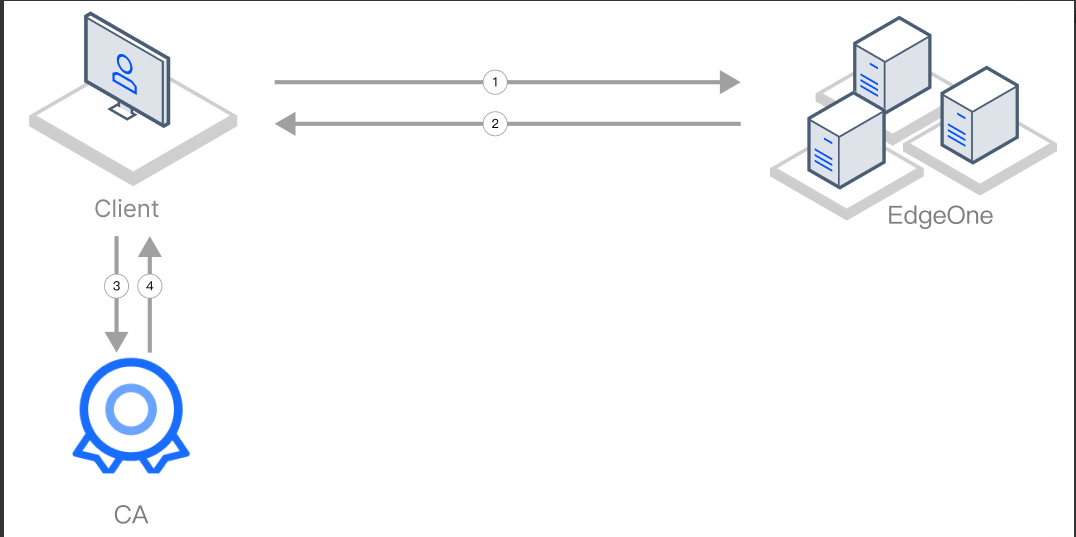Enabling OCSP Stapling
Overview
Online Certificate Status Protocol (OCSP) is provided by certificate authorities (CAs) to check the authenticity and validity of digital certificates. Whenever a user accesses a website over HTTPS, the browser initiates an OCSP query to verify whether the certificate of the website is still valid.
When OCSP stapling is enabled, EdgeOne performs OCSP queries and caches the results on servers. When a client initiates a TLS handshake with EdgeOne, EdgeOne responds with the OCSP information and certificate required for verification so that the client does not need to send a query request to the CA. This significantly improves the efficiency of the TLS handshake, reduces the time for verification, and improves the HTTPS request speed.
To enhance website performance and improve the efficiency of certificate status validation during HTTPS handshakes, you can enable OCSP stapling.
OCSP Stapling Disabled | OCSP Stapling Enabled |
 |  |
1. The client initiates a TLS handshake. 2. EdgeOne responds to the TLS handshake (by returning the certificate). 3. The client initiates an OCSP query. 4. The CA returns the result. | 1. The client initiates a TLS handshake. 2. EdgeOne initiates an OCSP query. 3. The CA returns the result, and EdgeOne caches the result. 4. EdgeOne responds to the TLS handshake (by returning the certificate and OCSP information). Because OCSP information is cached on EdgeOne servers, EdgeOne will respond to subsequent query requests without initiating a new OCSP query. |
Scenario 1: Enabling OCSP Stapling for All Domain Names
To enable OCSP stapling for all domain names used to access a site, refer to the following information.
Prerequisites
You have configured SSL certificates for all domain names used to access the current site as instructed in Certificate Configuration.
Directions
1. Log in to the Tencent Cloud EdgeOne console, enter Service Overview in the left menu bar, and click the site to be configured under Website Security Acceleration.
2. On the site details page, click Site Acceleration to enter the global site configuration page. Then click HTTPS in the right sidebar.
3. Locate the OCSP stapling configuration card. This protocol is disabled by default. Toggle the switch to enable it.

Off (default): When a client initiates a TLS handshake, the client must send a certificate verification request to the CA to check the certificate status in real-time.
On: EdgeOne sends a certificate verification request to the CA and caches the query results. When a client initiates an HTTPS request to the EdgeOne node, EdgeOne responds to the request by providing the certificate query results.
Scenario 2: Enabling OCSP Stapling for Specified Domain Names
To enable OCSP stapling for specified domain names, refer to the following information.
Prerequisites
You have configured SSL certificates for the specified domain names for which you want to enable OCSP stapling, as instructed in Certificate Configuration.
Directions
1. Log in to the Tencent Cloud EdgeOne console, enter Service Overview in the left menu bar, and click the site to be configured under Website Security Acceleration.
2. On the site details page, click Site Acceleration to enter the global site configuration page. Then click the Rule Engine tab.
3. On the rule engine management page, click Create rule and select Add blank rule.
4. On the page that appears, select HOST from Matching type and specify an operator and a value to match the requests of specified domain names.
5. From the Action drop-down list, select OCSP stapling, click Switch to enable the configuration.

6. Click Save and publish.